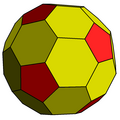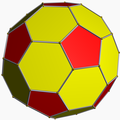| Chamfered dodecahedron | |
|---|---|
 | |
| Type | Goldberg polyhedron (GV(2,0) = {5+,3}2,0) Fullerene (C80) [1] Near-miss Johnson solid |
| Faces | 12 pentagons 30 irregular hexagons |
| Edges | 120 (2 types) |
| Vertices | 80 (2 types) |
| Vertex configuration | 60 (5.6.6) 20 (6.6.6) |
| Conway notation | cD = t5daD = dk5aD |
| Symmetry group | Icosahedral (Ih) |
| Dual polyhedron | Pentakis icosidodecahedron |
| Properties | convex, equilateral-faced |
| Net | |
 | |
In geometry, the chamfered dodecahedron is a convex polyhedron with 80 vertices, 120 edges, and 42 faces: 30 hexagons and 12 pentagons. It is constructed as a chamfer (edge-truncation) of a regular dodecahedron. The pentagons are reduced in size and new hexagonal faces are added in place of all the original edges. Its dual is the pentakis icosidodecahedron.
Contents
It is also called a truncated rhombic triacontahedron, constructed as a truncation of the rhombic triacontahedron. It can more accurately be called an order-5 truncated rhombic triacontahedron because only the order-5 vertices are truncated.




